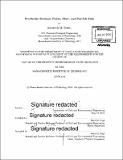Feedbacks between plants, flow, and particle fate
Author(s)
Follett, Elizabeth (Elizabeth Marie)
DownloadFull printable version (15.42Mb)
Other Contributors
Massachusetts Institute of Technology. Department of Civil and Environmental Engineering.
Advisor
Heidi M. Nepf.
Terms of use
Metadata
Show full item recordAbstract
Environmental flows carry a wide variety of particles that interact with vegetation. Vegetated canopies are anchored by sediment, release pollen and seeds to colonize new ground, rely on nutrients carried by sediment, and may be killed by disease spores. While the influence of vegetation on flow profiles has been investigated, the transport of particles within vegetated canopies remains poorly understood. In this thesis I present the results from laboratory experiments and numerical modeling that investigated particle fate and transport around emergent and submerged model vegetation canopies. The effect of canopy mediated flow on particle transport was explored in experimental studies using model vegetation. First, the flow diversion and extended wake region due to a circular patch of model reedy emergent vegetation resulted in regions of scour on the patch side and deposition in the patch wake, which are related to a non-dimensional flow blockage parameter. In-patch scour increased with turbulent kinetic energy levels, which were positively correlated to stem density. Second, within a long, submerged canopy, the capture of particles was reduced near the leading edge due to the presence of a vertical updraft. In the fully developed region, particle capture was increased for releases below the penetration of canopy scale vortices, and for particles with increased settling velocity. The impact of canopy flexibility on turbulence within the canopy was explored using a submerged canopy of model flexible vegetation. The drag reduction due to reconfiguration was described through a drag coefficient that decreased as a power-law function of velocity, with a negative exponent (Vogel number). Velocity measurements made within and above the canopy demonstrate that unsteady reconfiguration, responding to individual turbulent events, preferentially allows stronger sweeps to penetrate the canopy, enhancing the skewness. Next, spore escape was investigated across a range of canopy densities and particle settling velocities using a random displacement model (RDM) parameterized with an eddy diffusivity based on a simple set of physical parameters. This work filled a gap between field observations and traditional Lagrangian stochastic modeling, improving predictions of fungal spore escape to drive long range transport models. The effect of canopy and particle characteristics on the genotypic diversity of Zostera marina canopies was explored, pointing to the physical mechanisms governing successful pollination.
Description
Thesis: Ph. D., Massachusetts Institute of Technology, Department of Civil and Environmental Engineering, 2016. Cataloged from PDF version of thesis. Includes bibliographical references.
Date issued
2016Department
Massachusetts Institute of Technology. Department of Civil and Environmental EngineeringPublisher
Massachusetts Institute of Technology
Keywords
Civil and Environmental Engineering.